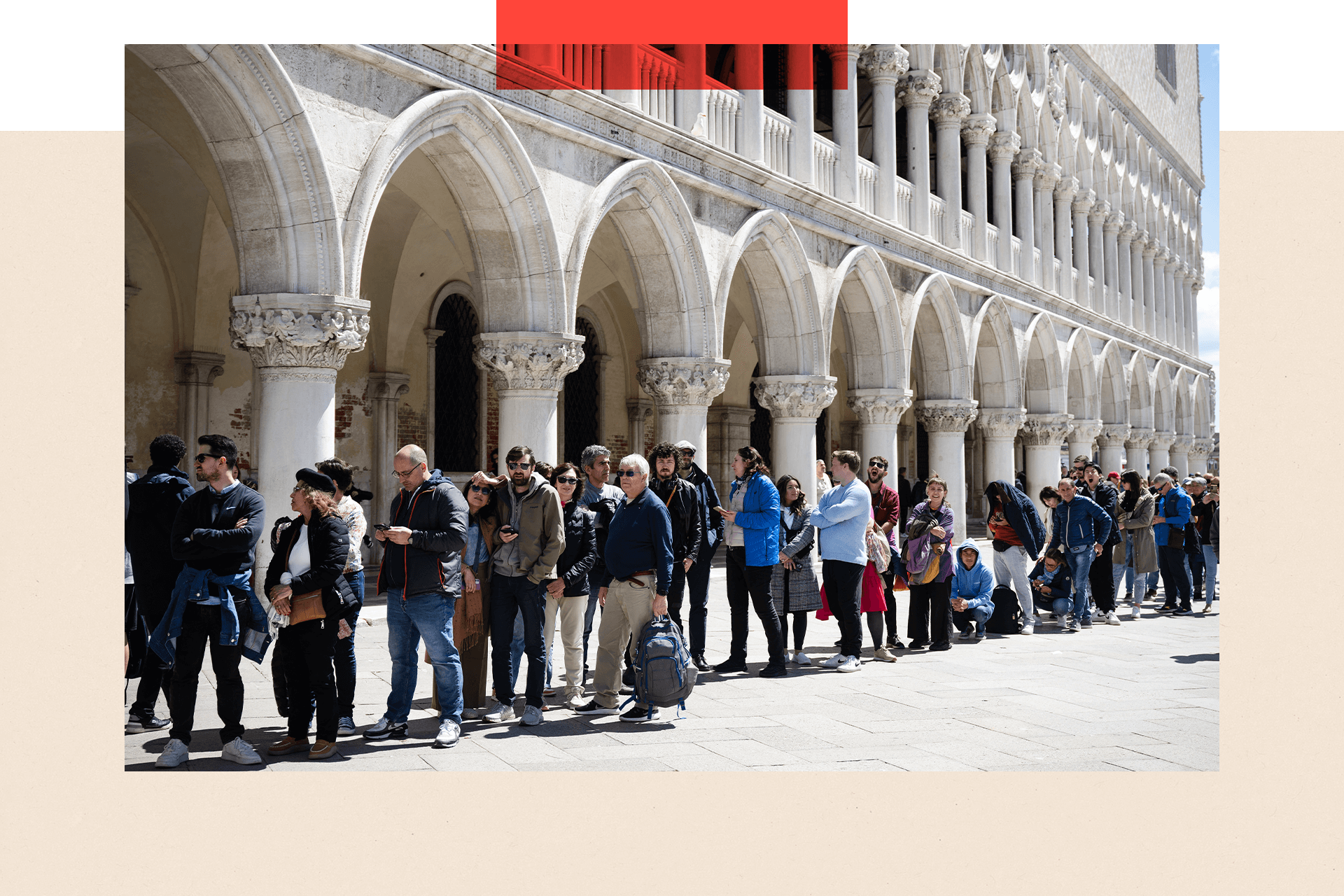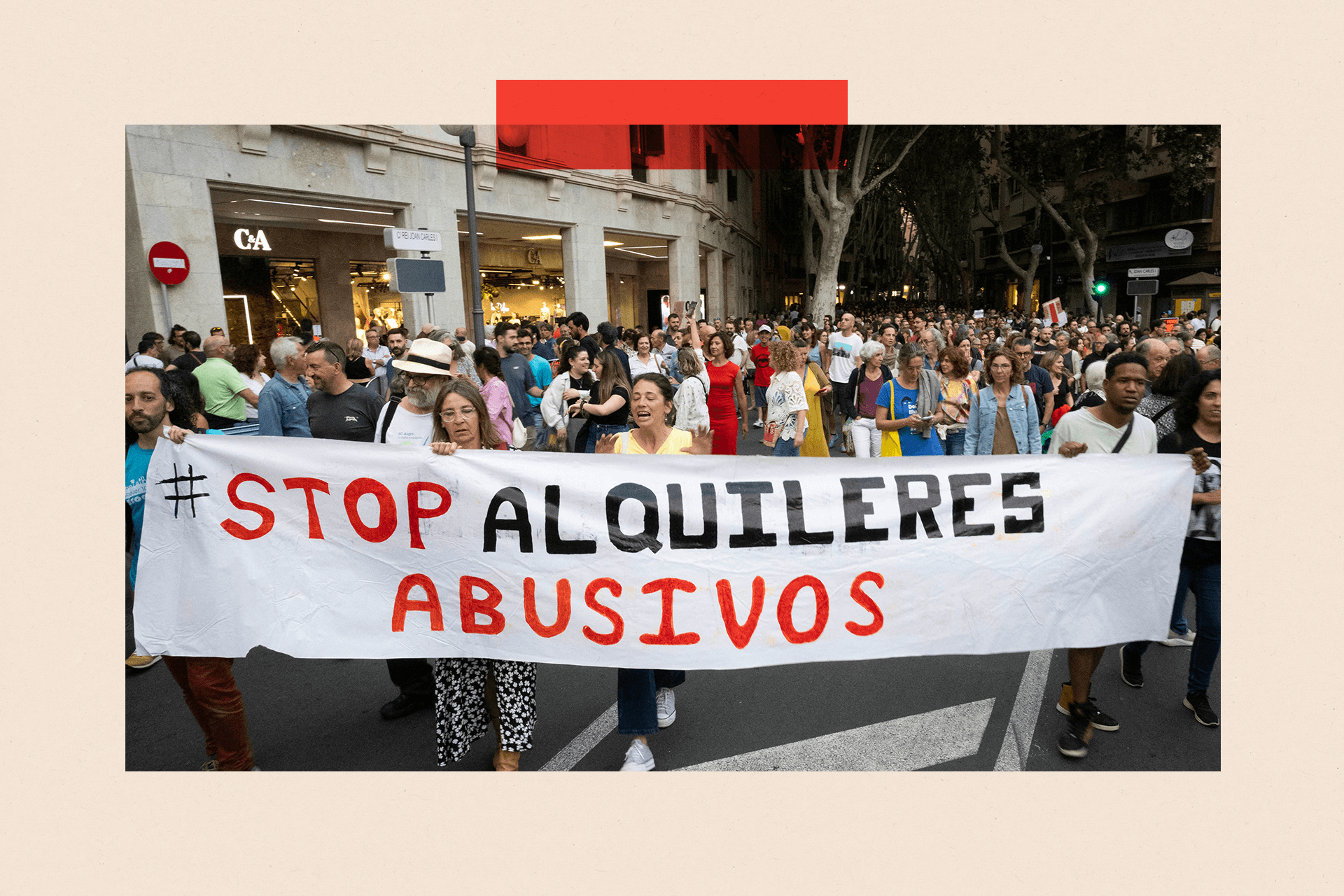
The message was scrawled on a makeshift wooden placard with black marker pen and was in block capitals. It said: "Everywhere you look everyone is foreign.”
Police said there were 10,000 marchers on the streets of Palma in Majorca on the last weekend of May at the start of the summer holiday season. Their message was that tourism was making life in Palma unliveable for locals.
But why does there suddenly seem to be such a strong sense of grievance in places where for decades large numbers of tourists have been the norm?
The answer, it would seem, is complicated. A Covid hangover is definitely a factor. But so too is the fact that, globally, many more people now have the money to travel. This presents big questions about the future of tourism.
The year 2024 is set to be a record-breaking one for tourism, surpassing the previous high in 2019. It appears that the travel and tourism industry is back with a vengeance after the pandemic, with any lingering doubts over the safety of travelling now banished.
In Spain’s Balearic Islands - which include Majorca - pent-up demand post pandemic has contributed to rents rising to such an extent that locals say they are being priced out of living in their own home towns. The BBC has reported on the story of a chef in Ibiza who has lived in his car for the past three years. Nurses, doctors and police officers are also said to be struggling to afford local rents.
It’s not hard to see why locals can end up feeling like extras in their own movie.
In spite of recessionary pressures, more people in the West feel they can afford regular foreign trips – indeed, some see it as an essential purchase and a virtual human right.

This sign read "Everywhere you look everyone is foreign"
The sentiment is similar around 1,500 miles away on the Canary Islands. They have been a favourite for Brits for decades and tourism has become a vital part of the economy. Today it accounts for 35% of the archipelago’s GDP and 40% of its jobs.
The cost of living for locals is an issue here too.
Chris Elkington is the editor of the local newspaper for English speakers, The Canarian Weekly. He started living in Tenerife in 1991 as an 18-30 holiday rep and has seen tourism flourish over the years.
But with that unchecked growth comes a downside: rental prices are too high for many locals and the average income in the Canaries is the lowest in Spain. Many hospitality staff have been forced to move away.
Mr Elkington says a constant increase in tourist accommodation has come at a price.
“A lot of landlords are now very wary and are moving away from renting their properties out long term and turning to holiday lets via online platforms,” he says. “The actual number of properties available has decreased massively and the price has increased exponentially. And unfortunately it's made finding somewhere to live very, very expensive.”
But in the Canaries, affordability is not the only issue. The environmental impact of tourism is also viewed by some as increasingly unsustainable.
At a demonstration attended by 20,000 people at the end of April, a spokesperson for the Canaries Have Had Enough collective said the situation has reached a critical mass: “We’ve reached the point where the balance between the use of resources and the welfare of the population has broken down, especially over the last year.”
Mr Elkington points to the fact that tourist areas with their large number of hotels and pools can use up to six times more water than resident areas.
“They keep building more hotels and expanding the area of tourism,” he says. “But unfortunately the resources that are here can't actually cope with it.”

The Tourist Trap: The travel industry is booming with millions more people holidaying abroad each year. How can we stop overtourism and protect the planet from its impact on the environment?

In the Italian city of Venice, a Unesco World Heritage site, school teacher Marta Sottoriva used to get into a small boat to block the huge cruise liners that regularly entered the city centre and offloaded thousands of day-trippers. That battle has been won - cruises are now restricted to the city’s industrial port.
But today fewer than 50,000 people actually live in Venice, compared to more than 150,000 in the 1970s.
Despite the cruise ship ban, Ms Sottoriva is not happy. “I know a lot of people who even if they have money, they have an income, they can’t find houses,” she says.
“We are at the level at which there are more tourist beds than there are beds for locals.”
The great danger of tourism is that an area is starved of a living flourishing mixed community with schools, local amenities and regular shops and instead becomes a historic theme park. “Disneyfied” is the description used by a lot of protestors.
So what measures are being taken to counter overcrowding in popular destinations?
One approach is to try to regulate the flow of visitors at peak times. This can be done by charging admission fees for day-trippers and providing data to potential visitors as to when the busiest times to avoid will be. Venice has just introduced a trial €5 fee for day trippers at the most popular times and many other famous historical attractions are raising their charges to tourists.
The new mantra being banded around by tourist boards is “high value, low volume”. This means catering to travellers who will spend a lot of money and are mindful of their presence in a fragile environment.
Another solution is to encourage people to avoid peak season travel and come in the “shoulder season”. Staggering school holidays could also prevent so many families descending on the same resort over an intense six-week period.
Many in the tourism industry also talk of “dispersal”. This means persuading tourists to go to alternative - similar, but less busy - destinations. Limiting car parking space is becoming a favoured approach to reduce the viability of coming just for day trips.
That doesn’t prevent tourist buses dropping off big groups, however. And it is hard to see how a tourist from, say South Korea, would not want to visit the Eiffel Tower and Venice, on their hard-earned first two week trip to Europe.

Some tourists now have to pay €5 (£4.25) to enter central Venice
It isn’t only in places that have been on the tourist trail for years that locals are feeling overwhelmed.
Hallstatt in Austria is an undeniably picturesque little lakeside Alpine village with a gorgeous panoramic view that could come out of a fairytale book. The common urban myth is that the town is the basis for Arendelle, the village in the hugely popular Disney movie Frozen.
I met a mother from South Korea who had brought her two young daughters dressed up as princesses for this very reason.
There are around 800 residents in Hallstatt who are simply dwarfed by the 10,000 or so daily visitors - many of whom descend from large tourist buses and proceed to walk around, sometimes through residents gardens, in search of the perfect selfie.
Some locals have had enough and last year a demonstration blocked the tunnel that leads road traffic into the town.
Dr Friedrich Idam, a long-time resident and urban architect, was one of them. He lives in a house on a hill that overlooks the lake. He told me that he doesn’t want tourists who only come for a day trip. He says they spend little money and have made life unbearable for him. “There’s no more public space for me and my co-inhabitants,” says Dr Idam.
"In the churchyard tourists take selfies and pose on the graves. The problem of Hallstatt is that it is so Instagrammable. If you come in your car and stay only for an hour, I say you are not welcome here.”
The mayor, Alexander Schuetz, is sympathetic but feels helpless: “Everybody knows it‘s just too much but we can’t just block the street and tell people you can’t come in because it’s a public right of way. It’s not a dead end because people go through Hallstatt going to other towns.”
Last year there was a short lived plan to stop congestion at a famous “selfie” site by the local council who put up a fence to block that particular viewpoint. They had to take it down when too many residents complained it blocked their own view of their beautiful lake.

Protesters in Majorca carried a banner that read "stop abusive rentals"
And then there is the emergence of new tourist markets with the disposable income and desire to explore the world as they have never been able to before.
Tourists from China first emerged as a major addition to the travelling global population in the early part of this century. And an even bigger source of international tourism is supplanting them in terms of impact.
India is the world’s fastest-growing major economy and now has the world’s largest population. A burgeoning affluent middle class in a country of 1.4 billion people is splashing the cash on dream trips to distant destinations.
Last year, 27 million Indian tourists travelled internationally and that’s predicted to soar to 70 million by 2030. Indian airlines have placed orders for almost a thousand new aircraft in anticipation of a big rise in demand.
Deepti Bhatnagar, who started India’s first ever travel show in 2000, says social media has played a major role in fuelling demand for travel among Indians. “They want to go to certain places to get the selfie or they think, ‘That’s one of the most photographed spots,’ and they have to be there,” she says.
The vast majority of the Indian population cannot afford to travel - but with such a huge population it only requires the tiny fraction of wealthy and even super-wealthy to enter the travel market and global figures are immediately significantly boosted. There are around 500 billionaires and a million millionaires in India. And many have expensive tastes.

This sign from the protest in Palma reads: "We live off tourism but tourism doesn't let us live"
It’s striking that while most things in life are becoming ever-more expensive, short-haul flying remains very cheap, sometimes less than a round of drinks in the pub. Orders for new commercial planes around the world are soaring. It’s estimated 3% to 4% of greenhouse emissions are caused by aviation and that figure is expected to rise as other industries go greener faster.
Meanwhile, there is an ethical conundrum to consider here - and with it a charge of hypocrisy. Many in the West, myself included, have enjoyed the fruits of the post-war travel boom, exploring far flung parts of the world without thinking of the unwanted consequences of mass tourism. So who are we now to preach to younger generations for whom gap years and backpacking are almost a rites of passage and indeed life enhancing experiences?
And who are we to lecture people from developing economies who can only now afford to do the same?
There appears to be no simple answer to who should be where and when, something nodded to by another of those placards back in Palma.
It read: “We live off tourism but tourism doesn't let us live.”
More from InDepth
Italy’s PM says fascism is ‘consigned to history’. Not everyone is so sure
- Published30 May 2024
Jeremy Bowen: Ukraine faces its worst crisis since the war began
- Published28 May 2024
Cynthia voted for Nelson Mandela. Now she's abandoning his successors
- Published25 May 2024
BBC InDepth is the new home on the website and app for the best analysis and expertise from our top journalists. Under a distinctive new brand, we’ll bring you fresh perspectives that challenge assumptions, and deep reporting on the biggest issues to help you make sense of a complex world. And we’ll be showcasing thought-provoking content from across BBC Sounds and iPlayer too. We’re starting small but thinking big, and we want to know what you think - you can send us your feedback by clicking on the button below.
Get in touch
InDepth is the home for the best analysis from across BBC News. Tell us what you think.

